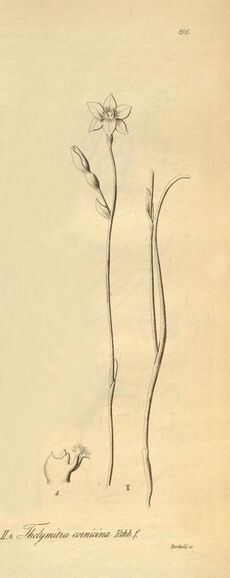Biology:Thelymitra cornicina
| Lilac sun orchid | |
|---|---|

| |
| Illustration from Reichenbach's Xenia Orchidacea | |
| Scientific classification | |
| Kingdom: | Plantae |
| Clade: | Tracheophytes |
| Clade: | Angiosperms |
| Clade: | Monocots |
| Order: | Asparagales |
| Family: | Orchidaceae |
| Subfamily: | Orchidoideae |
| Tribe: | Diurideae |
| Genus: | Thelymitra |
| Species: | T. cornicina
|
| Binomial name | |
| Thelymitra cornicina Rchb.f.[1]
| |
| Synonyms[1] | |
| |
Thelymitra cornicina, commonly called the lilac sun orchid,[2] is a species of orchid in the family Orchidaceae and is endemic to the south-west of Western Australia. It has a single narrow, pale green leaf and up to eight lilac-tinged blue flowers with the lobe on top of the anther covered with short, finger-like calli.
Description
Thelymitra cornicina is a tuberous, perennial herb with a single pale green leaf 100–200 mm (4–8 in) long and 3–5 mm (0.1–0.2 in) wide. Up to eight pale blue to dark blue flowers with a lilac tinge, 25–30 mm (0.98–1.2 in) wide are borne on a flowering stem 200–500 mm (8–20 in) tall. The sepals and petals are 10–15 mm (0.4–0.6 in) long and 6–8 mm (0.2–0.3 in) wide. The column is blue with a yellow crest, 3.5–4.5 mm (0.1–0.2 in) long and about 2 mm (0.08 in) wide. The lobe on the top of the anther is short and densely covered with short, finger-like yellow glands. The side lobes have mop-like tufts of a few white to lilac hairs. The flowers are insect pollinated and open on sunny days. Flowering occurs from September to November.[2][3][4]
Taxonomy and naming
Thelymitra cornicina was first formally described in 1871 by Heinrich Gustav Reichenbach and the description was published in Beitrage zur Systematischen Pflanzenkunde.[5] The specific epithet (cornicina) means "horn-blower", hence "horn-shaped", referring to the column.[3][6]
Distribution and habitat
The lilac sun orchid grows in scrubland and forest between Perth and Hopetoun in the Esperance Plains, Jarrah Forest, Swan Coastal Plain and Warren biogeographic regions.[2][3][7]
Conservation
Thelymitra cornicina is classified as "not threatened" in Western Australia by the Western Australian Government Department of Parks and Wildlife.[7]
References
- ↑ 1.0 1.1 "Thelymitra cornicina". World Checklist of Selected Plant Families (WCSP). Royal Botanic Gardens, Kew. http://wcsp.science.kew.org/namedetail.do?name_id=203730.
- ↑ 2.0 2.1 2.2 Jones, David L. (2006). A complete guide to native orchids of Australia including the island territories. Frenchs Forest, N.S.W.: New Holland. p. 245. ISBN 1877069124.
- ↑ 3.0 3.1 3.2 Brown, Andrew; Dundas, Pat; Dixon, Kingsley; Hopper, Stephen (2008). Orchids of Western Australia. Crawley, Western Australia: University of Western Australia Press. p. 433. ISBN 9780980296457.
- ↑ Hoffman, Noel; Brown, Andrew (2011). Orchids of South-West Australia. (3rd ed.). Gooseberry Hill: Noel Hoffman. p. 313. ISBN 9780646562322.
- ↑ "Thelymitra cornicina". APNI. https://id.biodiversity.org.au/instance/apni/522014. Retrieved 29 May 2018.
- ↑ Sharr, Francis Aubi; George, Alex (2019). Western Australian Plant Names and Their Meanings (3rd ed.). Kardinya, WA: Four Gables Press. p. 170. ISBN 9780958034180.
- ↑ 7.0 7.1 "Thelymitra cornicina". FloraBase. Western Australian Government Department of Parks and Wildlife. https://florabase.dpaw.wa.gov.au/browse/profile/1704.
External links
Wikidata ☰ Q9087252 entry
 |

